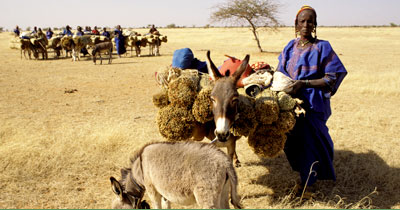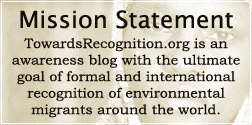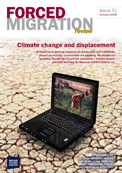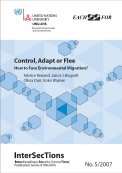“One of the gravest effects of climate change may be those on human migration”
— Intergovernmental Panel on Climate Change (IPCC), 1990

Photo credit: Africa Commission
.
Who are environmental migrants?
Environmental migrants are people who leave their homes due to both gradual environmental change and extreme environmental events. Environmental migrants are otherwise known by the broader public, as “climate refugees” or “environmental refugees”. When using the term “environmental”, this website places a focus on events that are associated with climate change which include “slow-onset disasters” such as rising sea levels, drought, and desertification. Research has shown that the increase and intensity of extreme weather events such as flooding, hurricanes, and cyclones are also linked to climate change.
The Intergovernmental Panel on Climate Change (IPCC) has shown that the poorest people in developing countries are bearing the burden of the impact of climate change even though they have contributed little or nothing to the problem. The consequences are drastic because they are least equipped to adapt to it.
Environmental migration is a reality that can no longer be overlooked. Millions of people have already been displaced as a result of climate change-related disasters. People are also moving from places they have long called home because their environment cannot support them anymore. For the first time ever, Red Cross research shows more people are now displaced by environmental disasters than by war (1). The United Nations University predicts that 50 million people globally will be displaced by environmental crises by the year 2010 (2). According to other experts in the field, there could be as many as 200 million displaced worldwide by 2050 (3). Although these numbers are expertly researched estimates, even the predictions on the lowest end of the scale are immense.
Migration itself not new, it has been going on for thousands of years. This phenomenon is new because there are more and more people that are forced to abandon their homes due to environmental factors related to climate change.
.
Why the term “environmental migrant” and not the widely used terms “climate refugee” or “environmental refugee”?
Recognizing that there is much debate within the international community about the terms “climate refugee” and “environmental refugee” (for an article on this issue click here), Towards Recognition has adopted the collective term of “environmental migrant”. The working definition of “environmental migrant” put forth by the International Organization for Migration (IOM) is aligned with the scope of the term on this website. This definition states:
“Environmental migrants are persons or groups of persons who, for reasons of sudden or progressive changes in the environment that adversely affect their lives or living conditions, are obliged to have to leave their habitual homes, or choose to do so, either temporarily or permanently, and who move either within their territory or abroad.”
Towards Recognition believes that maintaining consistency with the 1951 UN Convention Relating to the Status of Refugees, the United Nations agencies, larger migration INGOs and NGOs, and current research projects in using the term “environmental migrant”, is integral in implementing solutions to environmental migration and displacement.
.
Where will environmental migrants move to?
Despite the popular belief by the media and politicians, environmental migrant populations will not “flood rich nations”. Expert research has shown that the majority of people who have, or will move due to impact of climate change will do so within their own country, seeking new livelihoods and safety in nearby rural and urban areas. This will be either short-term or long-term depending on the nature of displacement. Many poorer communities and regions lack the resources to create sufficient climate change adaptation programs.
Long-term development is a key solution to the growing issue of climate-induced migration. In this regard, support from the international community through formal recognition of environmental migration is needed to ensure funding and domestic support to nearby migrant destinations, including small towns and large urban areas alike.
Migration as a result of an environment that is no longer inhabitable shouldn’t be completely regarded as negative. Rather, it should be realized as a viable opportunity for the building up of services and support in nearby rural areas, small towns, and urban centers to accommodate future migrant populations. Early and long-term development and new international and domestic policy to strengthen the capacity of the areas that migrants will move to based on future environmental and economic trends is crucial at this stage.
Given the lesser situation regarding those who will cross borders to escape the impact of climate change, the movement into neighboring countries is likely. There is a gap in international protection at this level which needs to be addressed. This includes those who will be affected by sudden-onset disasters and the catastrophic possibility of “sinking” small island states.
.
Are environmental migrants recognized by international law?
Despite the ongoing pressure by the international community to create a legal framework for recognizing, protecting, and resettling environmental migrants, no such instrument exists. The often complex mix of environmental, social, political, and economic factors that cause people to migrate is one reason why this has been slow in coming.
The Guiding Principles for Internal Displacement, which is a UN endorsed framework regarding the protection of people displaced within their own borders, does in fact cover those who are forced to move by “natural or human-made disasters”. However, there is still a severe protection deficit within this category in the Guiding Principles. Additionally, not all governments have signed up to this framework and although the majority of the movement is likely to occur within national borders, the Guiding Principles still do not apply to those who have crossed an international border.
This new category of migrants urgently needs to be formally recognized in new and well-formulated international agreements in order to establish policy, and better anticipate support and protection requirements, similar to those people fleeing other threatening situations. Unlike conventional refugees protected under current international treaties, there is little or no aid available to environmental migrants. Click here for the overall aim of this website regarding the formal recognition of environmental migrants in a new legal and international convention.
.
References:
1) International Federation of Red Cross and Red Crescent Societies (IFRC),
http://www.ifrc.org/publicat/wdr2001/
2) United Nations University – Institute for Environment and Human Security (UNU-EHS), http://www.ehs.unu.edu/index.php/article:130?menu=44
3) Myers, N. (2005) Environmental Refugees: An Emergent Security Issue, Organisation for Security and Cooperation in Europe, http://www.osce.org/documents/eea/2005/05/14488_en.pdf



